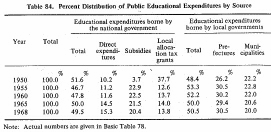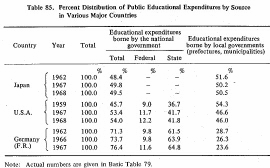| Home > Policy > White Paper, Notice, Announcement > White Paper > EDUCATIONAL STANDARDS IN JAPAN 1971 > CHAPTER |
||
The sources of educational expenditures in Japan, as distributed between the national government and IOCIII public bodies (prefectures and municipalities) are analyzed in Table 84.

Note: Actual numbers are given in Basic Table 78. Basic Table 78
Educational expenditures of the national government include direct expenditures for education by the national government and national subsidies for local educational expenditures. In addition, they include those local allocation tax grants expended for education. These three kinds of expenditures are considered national expenditures and are borne by the national treasury. Total public educational expenditures are shared almost equally by the national government and by local public bodies throughout the years shown. The proportions borne by prefectures and municipalities are 30% and 20%, respectively. Although little difference is noted from year to year in the sources of public educational expenditures, in recent years, the proportion of direct expenditures by the national government has been gradually increasing.
In Table 85, the distributions of the sources of public educational expenditures in Japan are compared with those in the U.S.A. and Germany (F.R.).

Note: Actual numbers are given in Basic Table 79. Basic Table 79
A strict comparison is difficult among these countries, because both the U.S.A. and the Federal Republic of Germany are federal states, while Japan is not. However, in the U.S.A., where the local governments establish public primary and secondary schools and share almost half the burden of total public educational expenditures, paying salaries of teachers etc., the share borne by the federal government has recently been increasing annually, as a result of the Elementary and Secondary Education Act and the Higher Education Act. Moreover, the share borne by the state governments is also increasing.
In Germany (F.R.), where the state governments pay the salaries of teachers and share more than sixty per cent of the total public educational expenditures, the share of the local governments has also decreased, while those of the federal and state governments have increased. Such increases in the share by the central governments (federal or state governments) in total public educational expenditures reflect the growing national demand for education in these countries.
| Back to Top | MEXT HOME |